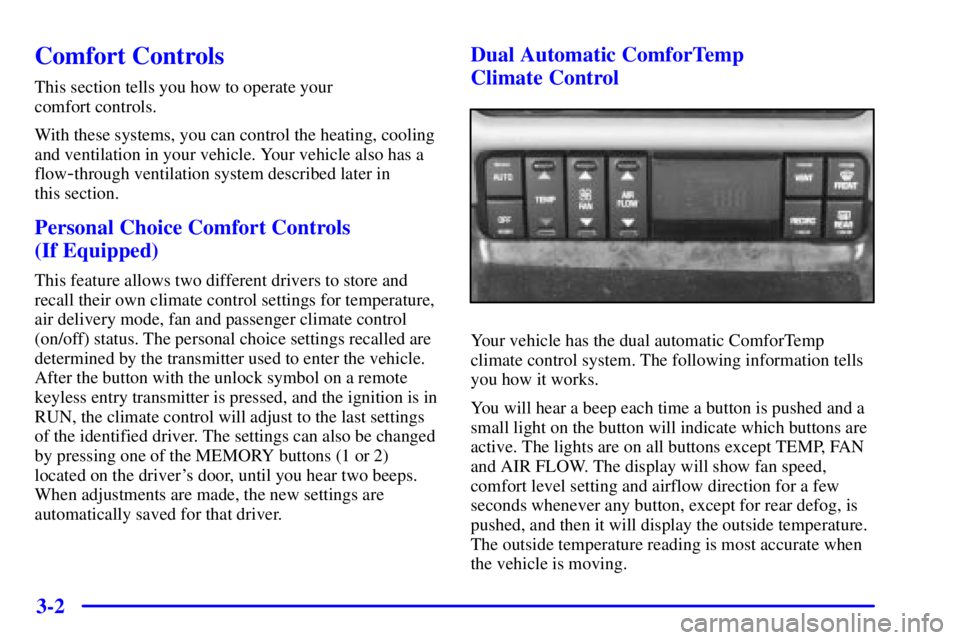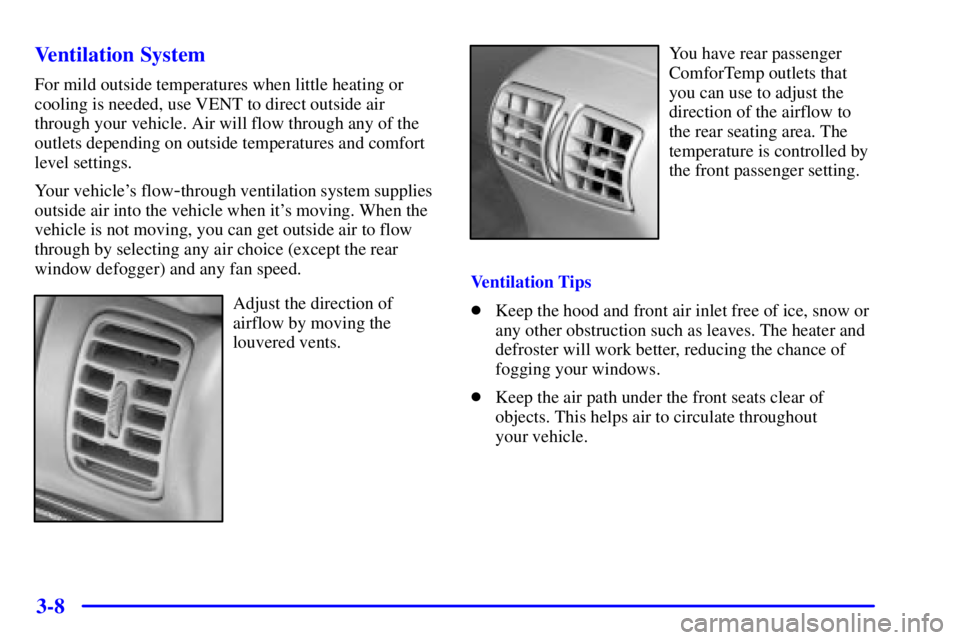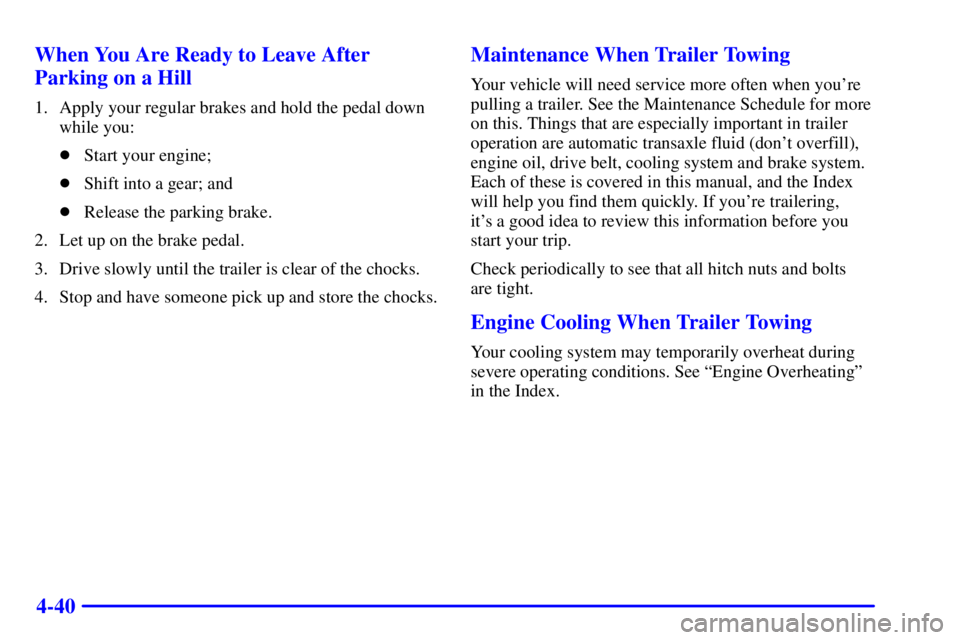Page 12 of 392
For
a More
Detailed Look at
What's Under the Hood
See Section 6
Tire Pressure
See Section 6
Service Station Guide
Oil Viscosity
Engine Oil
See Section 6
Engine Oil Dipstick
See Section 6
Remote Fuel
Door Release
See Section 6
Fuel
Use unleaded gas only,
See Section 6
Cooling System
See Section 5
Hood Release
See Section 6
Windshield Washer
Fluid
See Section 6
Spare Tire Pressure
See Section 5
Alternate
Fuel Door Release
See Section 6
Battery
See Section 6
Page 78 of 392

2-13 Resynchronization
After replacing the battery in your transmitter, or if only
the instant alarm works, the transmitter needs to be
resynchronized to the receiver. Do this by pressing and
holding both the button with the lock symbol and the
button with the unlock symbol at the same time for
about eight seconds. You must be within range of
the vehicle.
Once the transmitter has been resynchronized,
the horn will chirp and the exterior lamps will flash
once. The system should now operate properly.
Trunk
CAUTION:
It can be dangerous to drive with the trunk lid
open because carbon monoxide (CO) gas can
come into your vehicle. You can't see or smell
CO. It can cause unconsciousness and even death.
If you must drive with the trunk lid open or if
electrical wiring or other cable connections must
pass through the seal between the body and the
trunk lid:
�Make sure all other windows are shut.
�Turn the fan on your heating or cooling
system to its highest speed with the setting
on any airflow selection except RECIRC.
That will force outside air into your vehicle.
See ªComfort Controlsº in the Index.
�If you have air outlets on or under the
instrument panel, open them all the way.
See ªEngine Exhaustº in the Index.
Page 161 of 392

3-2
Comfort Controls
This section tells you how to operate your
comfort controls.
With these systems, you can control the heating, cooling
and ventilation in your vehicle. Your vehicle also has a
flow
-through ventilation system described later in
this section.
Personal Choice Comfort Controls
(If Equipped)
This feature allows two different drivers to store and
recall their own climate control settings for temperature,
air delivery mode, fan and passenger climate control
(on/off) status. The personal choice settings recalled are
determined by the transmitter used to enter the vehicle.
After the button with the unlock symbol on a remote
keyless entry transmitter is pressed, and the ignition is in
RUN, the climate control will adjust to the last settings
of the identified driver. The settings can also be changed
by pressing one of the MEMORY buttons (1 or 2)
located on the driver's door, until you hear two beeps.
When adjustments are made, the new settings are
automatically saved for that driver.
Dual Automatic ComforTemp
Climate Control
Your vehicle has the dual automatic ComforTemp
climate control system. The following information tells
you how it works.
You will hear a beep each time a button is pushed and a
small light on the button will indicate which buttons are
active. The lights are on all buttons except TEMP, FAN
and AIR FLOW. The display will show fan speed,
comfort level setting and airflow direction for a few
seconds whenever any button, except for rear defog, is
pushed, and then it will display the outside temperature.
The outside temperature reading is most accurate when
the vehicle is moving.
Page 165 of 392

3-6 Air Conditioning
On hot days, open the windows long enough to let hot
inside air escape. This reduces the time it takes for your
vehicle to cool down. Then keep your windows closed
for the air conditioner to work its best.
On very hot days, the system will automatically enter
the RECIRC mode and the temperature door will be
positioned at the full cold position for maximum
cooling. If the system is not in the AUTO mode,
RECIRC should be selected to provide maximum
cooling. You can choose the extreme comfort setting of
60�F (16�C), but the system will not cool any faster
by choosing the extreme comfort setting.
Heating
Press AUTO and adjust the temperature by pressing the
TEMP up or down arrow. You may also adjust the
ComforTemp system manually by pressing the AIR
FLOW button until FLOOR appears. Again, adjust the
temperature by pressing the TEMP up or down arrow.
Outside air is sent through the floor outlets. The heater
works best if you keep your windows closed.
Defogging and Defrosting
On cool but humid days, use FRONT to keep the
windshield and side windows clear and to quickly
remove fog, frost or ice from the windshield.
The fan speed will vary while in the AUTO mode. If a
manual fan speed setting is selected, the fan speed will
remain at that selection until the engine is turned off or
another selection has been made. To turn off FRONT,
press AUTO or AIR FLOW.
Rear Window Defogger
The lines you see on the
rear window warm the
glass. Press this button to
start warming your window.
Page 167 of 392

3-8 Ventilation System
For mild outside temperatures when little heating or
cooling is needed, use VENT to direct outside air
through your vehicle. Air will flow through any of the
outlets depending on outside temperatures and comfort
level settings.
Your vehicle's flow
-through ventilation system supplies
outside air into the vehicle when it's moving. When the
vehicle is not moving, you can get outside air to flow
through by selecting any air choice (except the rear
window defogger) and any fan speed.
Adjust the direction of
airflow by moving the
louvered vents.
You have rear passenger
ComforTemp outlets that
you can use to adjust the
direction of the airflow to
the rear seating area. The
temperature is controlled by
the front passenger setting.
Ventilation Tips
�Keep the hood and front air inlet free of ice, snow or
any other obstruction such as leaves. The heater and
defroster will work better, reducing the chance of
fogging your windows.
�Keep the air path under the front seats clear of
objects. This helps air to circulate throughout
your vehicle.
Page 221 of 392

4-26
If you drive regularly in steep country, or if you're
planning to visit there, here are some tips that can make
your trips safer and more enjoyable.
�Keep your vehicle in good shape. Check all fluid
levels and also the brakes, tires, cooling system and
transaxle. These parts can work hard on
mountain roads.
�Know how to go down hills. The most important
thing to know is this: let your engine do some of the
slowing down. Shift to a lower gear when you go
down a steep or long hill.
CAUTION:
If you don't shift down, your brakes could get so
hot that they wouldn't work well. You would
then have poor braking or even none going
down a hill. You could crash. Shift down to let
your engine assist your brakes on a steep
downhill slope.
CAUTION:
Coasting downhill in NEUTRAL (N) or with the
ignition off is dangerous. Your brakes will have to
do all the work of slowing down. They could get
so hot that they wouldn't work well. You would
then have poor braking or even none going down
a hill. You could crash. Always have your engine
running and your vehicle in gear when you
go downhill.
�Know how to go uphill. Drive in the highest
gear possible.
�Stay in your own lane when driving on two
-lane
roads in hills or mountains. Don't swing wide or cut
across the center of the road. Drive at speeds that let
you stay in your own lane.
�As you go over the top of a hill, be alert. There could be
something in your lane, like a stalled car or an accident.
�You may see highway signs on mountains that warn of
special problems. Examples are long grades, passing or
no
-passing zones, a falling rocks area or winding
roads. Be alert to these and take appropriate action.
Page 235 of 392

4-40 When You Are Ready to Leave After
Parking on a Hill
1. Apply your regular brakes and hold the pedal down
while you:
�Start your engine;
�Shift into a gear; and
�Release the parking brake.
2. Let up on the brake pedal.
3. Drive slowly until the trailer is clear of the chocks.
4. Stop and have someone pick up and store the chocks.
Maintenance When Trailer Towing
Your vehicle will need service more often when you're
pulling a trailer. See the Maintenance Schedule for more
on this. Things that are especially important in trailer
operation are automatic transaxle fluid (don't overfill),
engine oil, drive belt, cooling system and brake system.
Each of these is covered in this manual, and the Index
will help you find them quickly. If you're trailering,
it's a good idea to review this information before you
start your trip.
Check periodically to see that all hitch nuts and bolts
are tight.
Engine Cooling When Trailer Towing
Your cooling system may temporarily overheat during
severe operating conditions. See ªEngine Overheatingº
in the Index.
Page 236 of 392
5-
5-1
Section 5 Problems on the Road
Here you'll find what to do about some problems that can occur on the road.
5
-2 Hazard Warning Flashers
5
-2 Other Warning Devices
5
-3 Jump Starting
5
-7 Towing Your Vehicle
5
-8 Engine Overheating5
-10 Cooling System
5
-16 If a Tire Goes Flat
5
-17 Changing a Flat Tire
5
-26 Compact Spare Tire
5
-27 If You're Stuck: In Sand, Mud, Ice or Snow